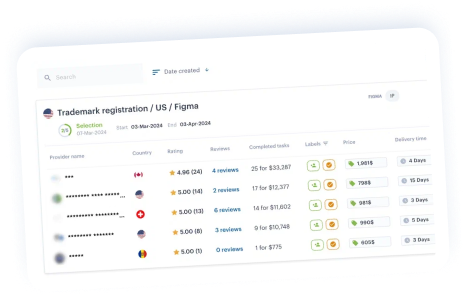Spain is one of the largest and most populous countries in Europe, with a population of over 46 million people. It is also a major economic power, ranking as the fourth largest economy in the European Union. With such a large population and strong economic presence, it is no surprise that Spain is also a popular destination for trademark registration. In 2020, there were over 68,000 trademark applications filed in Spain, making it one of the top countries for trademark registrations in Europe.
Contents
1. What can be registered as a trademark in Spain?
2. Reasons for refusals of a trademark application in Spain
3. The process of trademark registration in Spain
4. Documents required for the registration of trademark in Spain
5. Trademark opposition process in Spain
7. Why should you file a trademark in Spain?
1. What can be registered as a trademark in Spain?
In Spain, a trademark can be any sign or combination of signs that are capable of distinguishing the goods or services of one company from those of another. This includes words, logos, slogans, shapes, colors, sounds, and even smells. However, the sign must be distinctive and not be descriptive of the goods or services it represents. This means that it cannot be a common word or phrase that is commonly used to describe the product or service.
2. Reasons for refusal of a trademark application in Spain
Like most countries, Spain has certain grounds for refusing a trademark application. These include:
– Lack of distinctiveness: As mentioned before, a trademark must be distinctive in order to be registered. If it is too generic or descriptive, it will be refused.
– Deceptiveness: A trademark that is likely to deceive the public about the nature, quality, or geographical origin of the goods or services will also be refused.
– Similarity to existing trademarks: If a trademark is too similar to an already registered trademark, it may be refused in order to avoid confusion among consumers.
– Immoral or offensive trademarks: Trademarks that go against public order or morality will not be registered.
– Prohibited signs: Certain signs such as national flags or emblems cannot be registered as trademarks.
3. The process of trademark registration in Spain
The process of registering a trademark in Spain begins with the filing of an application with the Spanish Patent and Trademark Office (SPTO). The application must include the following information:
– The name and address of the applicant;
– A representation of the trademark;
– A list of the goods or services for which the trademark will be used;
– The class(es) of goods or services according to the Nice Classification system;
Once the application is filed, it will undergo a formal examination to ensure that all the necessary information is provided. If there are any deficiencies, the applicant will be given a period of time to correct them. After the formal examination, the application will be published in the Official Gazette for opposition purposes.
4. Documents required for the registration of a trademark in Spain
In addition to the information listed above, there are certain documents that must be submitted along with the trademark application in Spain. These include:
– A power of attorney, if the application is filed through an agent;
– A priority document, if claiming priority from an earlier application;
– A certified copy of any foreign registration, if applicable.
5. Trademark opposition process in Spain
After the trademark application is published in the Official Gazette, there is a two-month period during which any interested party can file an opposition against the registration of the trademark. The grounds for opposition are similar to those for refusal of a trademark application. If an opposition is filed, the applicant will have an opportunity to respond and present arguments in favor of their trademark. If no opposition is filed, or if the opposition is unsuccessful, the trademark will proceed to registration. Also check the pitfalls of trademark rebranding.
6. Trademark costs in Spain
The cost of registering a trademark in Spain can vary depending on several factors, such as the number of classes of goods or services:
| Professional fee for one class | $210 |
| Government fee for one class | $137 |
| Professional fee for each additional class | $92 |
| Government fee for each additional class | $90 |
The trademark registration cost in Spain via the iPNOTE platform starts from as low as $347, which includes all government fees and document preparation. Find the best IP attorney in Spain on iPNOTE.
7.Why should you file a trademark in Spain?
There are several reasons why businesses should consider filing a trademark in Spain:
– Protection: Registering a trademark in Spain provides legal protection against others using the same or similar trademark for similar goods or services. This can help prevent confusion among consumers and maintain the reputation of the brand.
– Market expansion: Registering a trademark in Spain can open up new markets and opportunities for businesses looking to expand their reach in Europe.
– Enforceability: A registered trademark in Spain can be easily enforced through legal action in case of infringement, making it a valuable asset for businesses.
8. Conclusion
Registering a trademark in Spain can be a valuable step for businesses looking to establish and protect their brand in Europe. With a straightforward process and relatively low costs, it is an accessible option for both local and foreign companies. However, it is important to ensure that the trademark meets all the necessary requirements and is properly protected to avoid any potential issues in the future. Consulting with an experienced IP attorney can help navigate the process and ensure a successful registration.
***
The iPNOTE platform features more than 700 IP law firms that cover more than 150 countries, so you can always find the right direct service provider using our flexible filtering system.
Need help with IP services? Create a task with our AI Assistant and get offers during 48 hours.
Sign up for free, and we’ll help you solve any IP-related problem
Also note: EU trademark registration, Canadian trademark registration.







